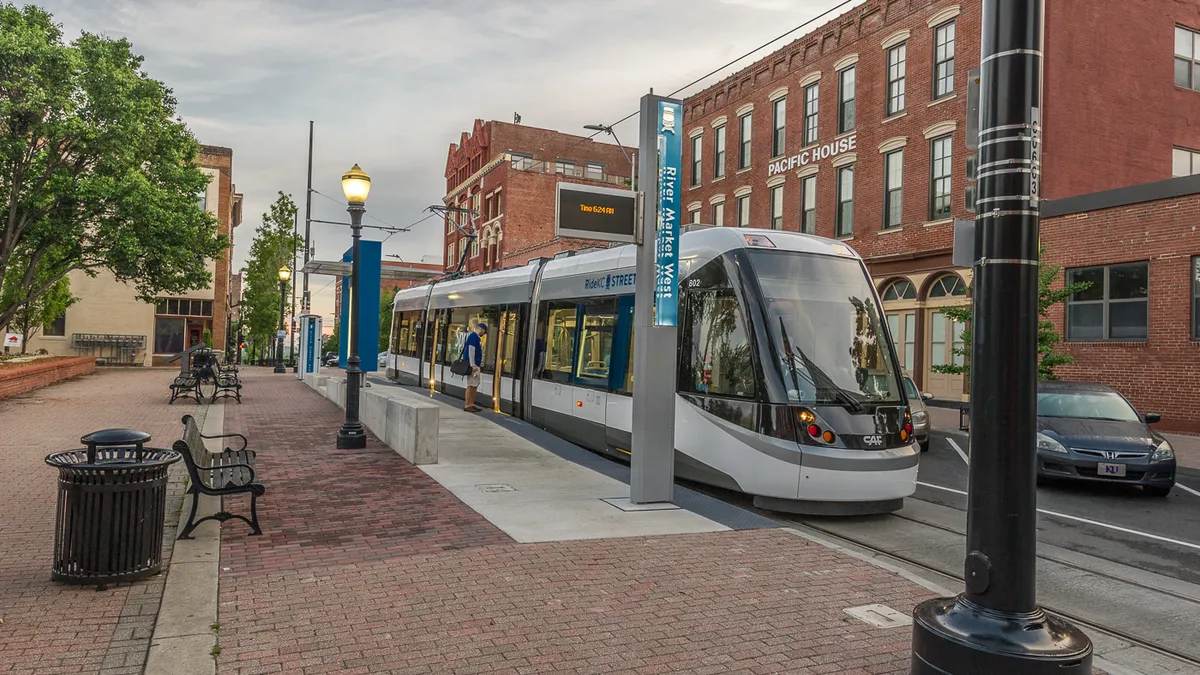Dive Brief:
- Modern streetcar systems constructed since 2001 have achieved different outcomes depending on each city’s goals, according to Joel Mendez, an assistant professor of urban planning at the University of Kansas, speaking on a Sept. 27 Transportation Research Board webinar.
- Some streetcar systems improved transit in downtown areas with routes serving existing centers of activity, Mendez said, while others revitalized underdeveloped areas.
- Streetcar systems’ accessibility, fare policies and connections with other transit such as bus and light rail played a role in how well a given system attracted ridership and met its goals, Mendez said.
Dive Insight:
Electric streetcars, also known as trolleys, became commonplace in cities and suburbs from 1890 to 1930, but increasing automobile ownership and bus transportation in the 1940s and 1950s led to the demise of most streetcar systems. In the 21st century, cities have shown renewed interest in streetcars, with Portland, Oregon, building a new line in 2001 followed by other cities such as Atlanta, Dallas and Milwaukee.
In 2018, Mendez compared systems in Atlanta; Cincinnati; Kansas City, Missouri; and Tucson, Arizona. Atlanta and Cincinnati looked to achieve “a greater emphasis on maximizing the economic development impact of the streetcar system,” he said, designing routes “traversing undeveloped or underdeveloped land.” In Cincinnati, that included an area with more than 460 vacant properties and 97 acres of vacant land. Atlanta’s route covered a region with 40 acres of vacant property and 40 empty buildings and did not connect with Georgia State University or the city’s Centennial Park.
Lori Burchett, deputy director for streetcar services with the city of Cincinnati, speaking on the webinar, acknowledged that the service “had a bit of a rocky start.” The city then took over management of the system from a local regional transit authority in 2020 and eliminated fares after suspending service during the first months of the COVID-19 pandemic.
Burchett said the Cincinnati Connector streetcar system hit the 100,000 monthly riders milestone for the first time in October 2022 and continues to grow, remaining fare-free. “We've seen major development, local investments along the Connector route,” Burchett said. Prior to the streetcar opening in 2016, 90% of the properties in the area were vacant and abandoned,” she added: “Now these properties are, or have been, restored and preserved and full of new businesses.” Year-to-date ridership in 2023 exceeds 1 million, according to city data.
Mendez noted, however, that “there's a threshold where streetcar service areas can be too underdeveloped” and it may take some time before development occurs. In comparison, Kansas City’s streetcar system was located in the downtown core, said Tom Gerend, executive director at the KC Streetcar Authority, speaking on the webinar. Ridership peaked in 2019 at over 2.2 million rides and is still recovering from pandemic lows. KC Streetcar has always been fare-free. Gerend explained the organization is now looking to expand outside the city center: “We're ready to reinvest in transit and Main Street, and we want to do that through an upgraded service opportunity with streetcars.”
For streetcar systems to achieve success, Mendez recommended anchoring systems to existing activity centers and tapping into the existing base of transit ridership by making it easy for riders to connect with other transit options through tailored fare policies or infrastructure.












